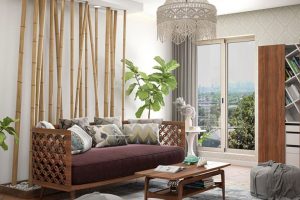How to Incorporate Sustainable and Eco-Friendly Decor in Your Home

Why Choose Sustainable and Eco-Friendly Decor?
As more individuals become conscious of their environmental impact, the shift towards sustainable and eco-friendly decor has gained momentum. Making these choices not only enhances the aesthetics of a home but also fosters a healthier planet. Let’s delve deeper into the compelling reasons to embrace sustainable decor.
- How to Incorporate Sustainable and Eco-Friendly Decor in Your Home
- Why Choose Sustainable and Eco-Friendly Decor?
- Benefits of Sustainable Decor
- Environmental Impact of Traditional Decor
- Implementing Sustainable Practices in Home Decor
- Use of Recycled Materials
- Energy-Efficient Lighting
- Choosing Eco-Friendly Furniture and Textiles
- Bamboo Furniture
- Organic Cotton Textiles
- Incorporating Indoor Plants for a Green Home
- Benefits of Indoor Plants
- Low-Maintenance Plant Options
- Sustainable DIY Home Decor Projects
- Upcycling Furniture
- Creating Eco-Friendly Art Pieces
Benefits of Sustainable Decor
Choosing sustainable decor is not just a trend; it’s a lifestyle shift that brings numerous benefits:
- Healthier Home Environment: Sustainable materials often contain fewer toxic chemicals compared to conventional products. This means cleaner air quality, which is especially important for families with children or individuals with respiratory concerns.
- Long-lasting Quality: Items made from sustainable materials like reclaimed wood or bamboo are often more durable, meaning they will withstand the test of time. For example, a beautifully crafted bamboo chair might not only look stunning but can also last a lifetime.
- Unique Aesthetic: Eco-friendly decor often has a distinct charm, with many pieces having unique textures and stories. Choosing reclaimed materials can offer a vintage, rustic vibe that mass-produced items simply can’t replicate.
- Support Local Economies: By purchasing sustainable decor, you’re often supporting local artisans and businesses. This creates a positive ripple effect in your community, promoting craftsmanship and unique local styles.
Environmental Impact of Traditional Decor
In contrast, traditional decor practices can have significant negative effects on the environment.
- Deforestation: Many conventional decor items are made from unsustainably sourced wood, contributing to deforestation. As trees are cut down, ecosystems are disrupted and biodiversity is lost.
- Resource Intensive: Producing traditional decor typically requires extensive water and energy use, from manufacturing to transportation. This not only depletes natural resources but also leads to a substantial carbon footprint.
- Landfill Waste: Many mass-produced items end up in landfills after relatively short periods of use, contributing to the growing waste crisis. Sustainable decor, in contrast, emphasizes longevity and waste reduction.
By opting for sustainable and eco-friendly decor, individuals are making a conscious decision that benefits both their homes and the Earth. This powerful choice creates a brighter future filled with healthier living options and a commitment to preserving our planet for generations to come.
Implementing Sustainable Practices in Home Decor
Transitioning your home decor to a more eco-friendly approach is an exciting journey. It’s about making smarter choices that not only enhance your living space but also contribute positively to the environment. Let’s explore practical methods that are easy to integrate into your home.
Use of Recycled Materials
One effective way to embrace sustainability in home decor is through the use of recycled materials. By selecting items made from repurposed goods, homeowners can reduce waste while enjoying unique decor pieces.
- Furniture: Consider pieces crafted from reclaimed wood or upcycled metal. For example, a coffee table made from old barn wood can add rustic charm to your living room while telling a story of its past life.
- Decorative Items: Many artisans create beautiful home accessories using reclaimed materials. Think about vibrant throw pillows made from recycled fabrics or vases formed from repurposed glass. These items not only reduce waste but also serve as conversation starters.
Integrating recycled materials into your home allows for creativity and individuality, ensuring that your space truly reflects your personality while being kind to the planet.
Energy-Efficient Lighting
Another vital aspect of sustainable home decor involves optimizing energy-efficient lighting. This not only lowers your energy bill but also minimizes your carbon footprint.
- LED Bulbs: Switching to LED bulbs can save up to 80% more energy compared to traditional incandescent bulbs. They last significantly longer, too, meaning less frequent replacements. For instance, replacing a few standard bulbs in your living room with LEDs can create a warm, inviting atmosphere while saving you money in the long run.
- Natural Light Utilization: Make the most of natural light by using lighter window treatments or strategically placing mirrors to reflect sunlight throughout your space. This practice not only brightens your home but also reduces the need for artificial lighting during the day.
Incorporating energy-efficient lighting solutions contributes to a sustainable lifestyle, making your home more eco-friendly and comfortable. By implementing these sustainable practices, homeowners can create beautiful, unique spaces that are environmentally responsible, charming, and chic. Each small choice contributes to a larger impact, paving the way for a greener, more sustainable future.
Choosing Eco-Friendly Furniture and Textiles
As the journey towards sustainable home decor continues, the selection of furniture and textiles plays a crucial role. Opting for eco-friendly options not only enhances the aesthetic appeal of your home but also contributes to a healthier planet. Let’s dive into two popular choices: bamboo furniture and organic cotton textiles.
Bamboo Furniture
Bamboo is emerging as a top contender in the world of eco-friendly furniture, and for good reason. This versatile material is not only durable but also one of the fastest-growing plants on Earth, making it a renewable resource.
- Sustainability: Bamboo can grow up to three feet in a single day without the need for pesticides or herbicides, making it an incredibly sustainable choice. For instance, a well-crafted bamboo dining table can impart a modern and chic vibe to your dining area while ensuring that fewer trees are cut down.
- Durability: Furniture made from bamboo is known for its strength and resilience. It can resist warping, making it perfect for various climates. Imagine a sturdy bamboo bench for your outdoor space, offering a stylish yet durable seating option that lasts through different seasons.
- Aesthetic Appeal: Bamboo offers a unique and contemporary look. Its natural beauty works wonderfully with any decor style, from minimalist to bohemian.
Organic Cotton Textiles
When it comes to textiles, choosing organic cotton is a game-changer. Not only is it gentle on the skin, but it also minimizes the environmental footprint compared to conventional cotton.
- Chemical-Free Production: Organic cotton is grown without harmful pesticides or synthetic fertilizers, making it safe for both the environment and the farmers who cultivate it. Picture snuggling into a set of soft, organic cotton sheets—knowing that they were produced sustainably makes the experience even sweeter.
- Biodegradable: Unlike synthetic textiles, organic cotton is fully biodegradable, which means it won’t contribute to landfill waste in the long term. This makes your commitment to eco-friendly decor even more impactful.
- Versatile Use: Organic cotton can be found in various home textiles, from curtains to cushions. Combining organic cotton throw pillows with your bamboo furniture creates a cozy, eco-friendly ambiance that many will admire.
Choosing eco-friendly furniture and textiles, like bamboo and organic cotton, allows homeowners to curate spaces that reflect their values while enjoying comfort and style. With these options, it’s easy to make stylish choices that protect the planet.
Incorporating Indoor Plants for a Green Home
With the focus on sustainable home decor shifting towards a more organic feel, incorporating indoor plants is a simple yet effective way to add life and vibrancy to your space. Not only do these green companions enhance the aesthetic appeal of a home, but they also bring along several amazing benefits.
Benefits of Indoor Plants
Integrating indoor plants into your living space comes with a variety of advantages that go beyond mere decoration:
- Improved Air Quality: Indoor plants act as natural air purifiers by absorbing toxins like formaldehyde and benzene. For instance, having a Peace Lily in your living room can help clear the air, making your home healthier and fresher.
- Enhanced Mood and Productivity: Studies have shown that indoor plants can contribute to increased focus and reduced stress levels. Imagine working from home with a few succulents on your desk; their calming presence can boost your productivity and mood.
- A Natural Humidifier: Plants release moisture vapor during transpiration, which can increase humidity levels indoors. This can be particularly helpful in arid climates, improving skin health and reducing respiratory issues.
- Connection to Nature: Bringing greenery indoors fosters a sense of tranquility and connection to nature, which is especially valuable in urban settings.
Low-Maintenance Plant Options
For those who might hesitate to incorporate indoor plants due to concerns about care requirements, there are plenty of low-maintenance options available that are perfect for every lifestyle.
- Snake Plant (Sansevieria): This hardy plant tolerates low light and irregular watering, making it ideal for beginners. With its striking upright leaves, it adds a sense of modern elegance to any corner of the home.
- Pothos (Epipremnum aureum): Known for its trailing vines, Pothos thrives in a range of environments and is forgiving if you forget to water it occasionally. It’s perfect for hanging baskets or as a shelf accent.
- ZZ Plant (Zamioculcas zamiifolia): The ZZ plant is nearly indestructible and can survive low light and infrequent watering. Its glossy leaves offer a sophisticated touch, and it’s often recommended for busy households or offices.
- Spider Plant (Chlorophytum comosum): A classic houseplant that’s easy to grow and propagate. Its arching leaves and small “baby” plants make it a fun and rewarding choice.
Incorporating indoor plants into your home decor not only adds aesthetic value but also promotes a healthier living environment. By choosing low-maintenance options, anyone can experience the joy of caring for plants without feeling overwhelmed. Embrace the greenery, and watch your space transform into a calming sanctuary!
Sustainable DIY Home Decor Projects
As the journey towards a more sustainable lifestyle continues, engaging in DIY home decor projects can be incredibly rewarding. Not only are these projects fun and creative, but they also help minimize waste and promote eco-friendly practices. Two popular avenues for sustainable DIY are upcycling furniture and creating eco-friendly art pieces.
Upcycling Furniture
Upcycling furniture is a fantastic way to breathe new life into old pieces while embracing sustainable living. This not only reduces waste but also allows you to create unique items that reflect your style.
- Refresh with Paint: Take an old wooden chair or dresser and give it a new look with a fresh coat of non-toxic paint. For instance, I transformed a worn-out wooden coffee table into a vibrant accent piece in my living room, using biodegradable paint that added color without harmful chemicals.
- Mix and Match: Why buy new furniture when you can combine existing pieces? Consider using parts from different items to create something innovative. I once took the legs from an old table and attached them to a repurposed wine barrel to create a fun, rustic bar table.
- Add New Hardware: Swapping out old knobs and handles on cabinets or drawers can make a huge difference. Choosing unique or vintage hardware can instantly elevate the look of a piece.
Creating Eco-Friendly Art Pieces
Art can also be a medium for sustainability. By crafting eco-friendly art pieces, you contribute to a greener lifestyle while expressing your creativity.
- Natural Materials: Utilize materials found in nature, such as twigs, leaves, and stones, to create stunning wall hangings or centerpieces. For example, I made a beautiful framed piece of artwork using pressed flowers and leaves collected on a hike, showcasing the beauty of nature right in my home.
- Recycled Paper Art: Use old magazines or newspapers to create collages or paper mâché projects. Not only does this give new life to materials that would otherwise end up in the trash, but it also allows for a plethora of artistic expression.
- Upcycled Fabric Creations: Turn old clothes or fabrics into beautiful throw pillows or wall art. I recently stitched together various fabric swatches to create a colorful patchwork cushion that adds a cozy feel to my couch.
Embarking on sustainable DIY home decor projects, like upcycling furniture and creating eco-friendly art pieces, not only beautifies your home but also supports a more sustainable world. These projects invite creativity, serve as conversation starters, and ultimately reduce waste—proving that you can make a positive impact with a little effort and imagination.





